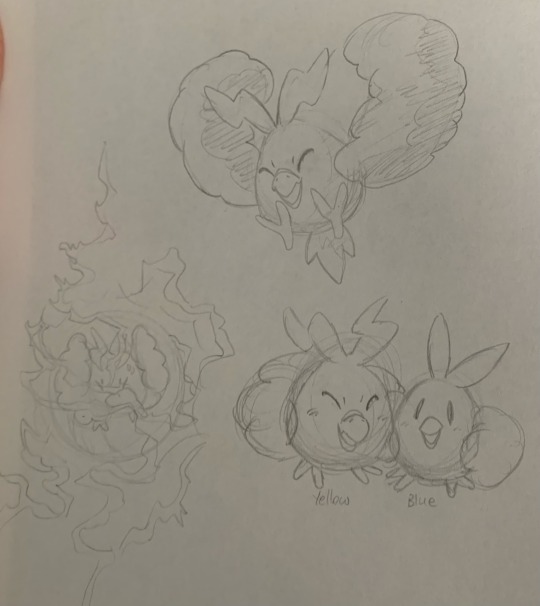#theyre dryer sheets. theyre powerline pigeons. theyre lovebirds. they scratch the ground like chickens.
Note
Ooo how about electric or ghost type swablu :o

this ask is well over two years old but i have been thinking about it. like normal. and workshopping here and there and its become a very fun thing for me to think about. im so glad you sent this in however late it is im sharing any semblance of seeing it.
• electric/flying swablu. swablu being white and blue normally like a sunny, partly cloudy sky, electric swablu is yellow and grey! (the shinies come closer to og swablu)
• they can collect and store static electricity by rubbing their wings, either together or on surfaces with good friction. theyre friendly and have a sense of humor, often teasing peoples hair or finding items that stick to their other electric swablu friends' wings.
• being social, these pokemon are frequently seen rubbing their wings against one another in an act that looks much like cuddling, but is likely an act to accrue static with the help of a friend. trainers will find their own swablu may do this to them, giving them an affectionate impression.
• "lightning ball" anomaly sightings where they live tend to be debunked as this pokemon discharging an unusual excess of accrued charge. they can store a frightening amount of power, and it isn't uncommon for young ones to have to learn how to manage it reliably.
• if you see many of this pokemon lining up densely on power lines, take care! its likely that the insulation is worn and these swablu have been attracted by the loose static.
• ... its even more worth it to be wary when its much larger, heavier evolution is attracted by the same. being friendly itself, and forgetting its size and weight, it will want to land together with its smaller swablu kind and socialize. comically, it's nearly guaranteed it will end up scattering the swablu when its weight and rough landing jar the power line.
• eating tougher grains and seeds gives this pokemon a slightly sturdier beak than its normal/flying counterpart. its slightly larger overall as well, but typically not by much.
#theyre dryer sheets. theyre powerline pigeons. theyre lovebirds. they scratch the ground like chickens.#theyre silly little guys.#and ball lightning!#theyre already borbs fjdj its good#i have more in another sketchbook but i think this is at least a good enough place to post first fjdfj#i keep telling myself 'oh ill post when i color it' and then get stressed still fjdjf#so!!! electric swablu. i give... sketches fjdj but its okay its for fun#pokemon#fakemon#raespark#return to sender#thank you for sending this in im sure it was forgotten about but fjdj not by me#skelly sketches#skelly draws
14 notes
·
View notes